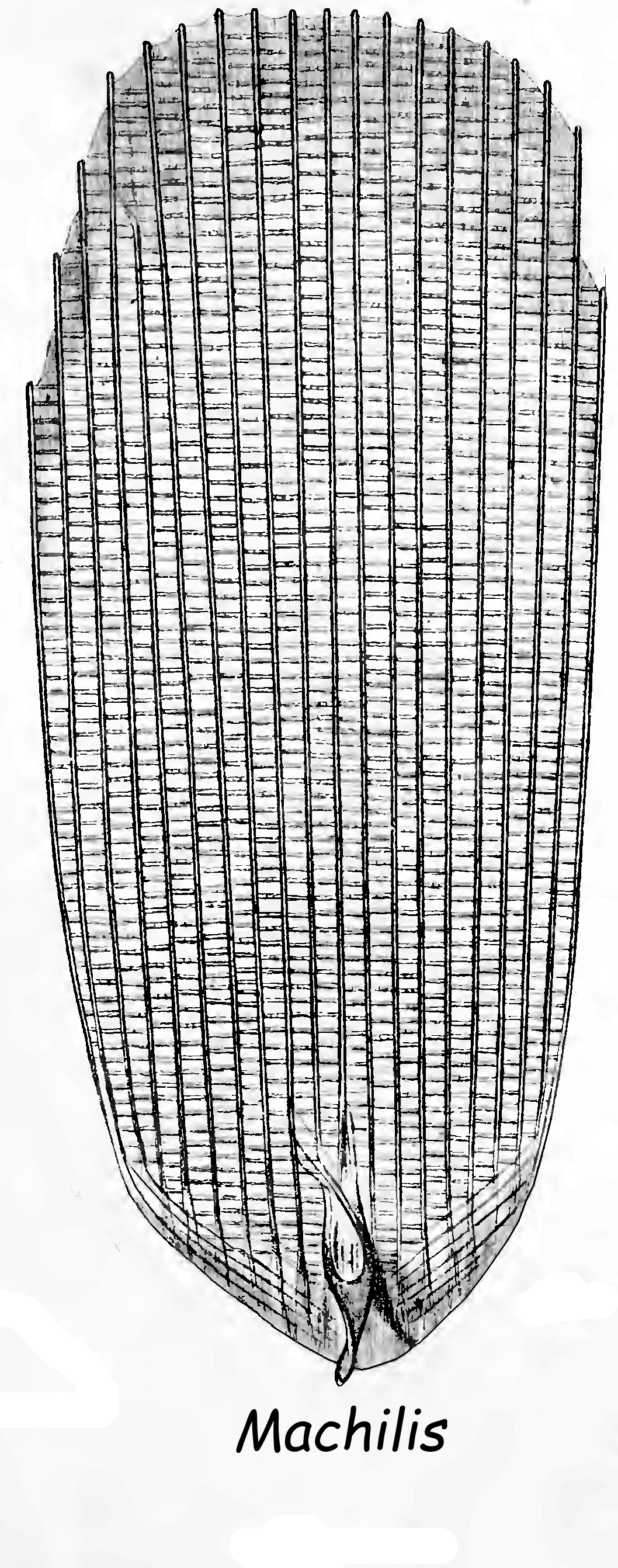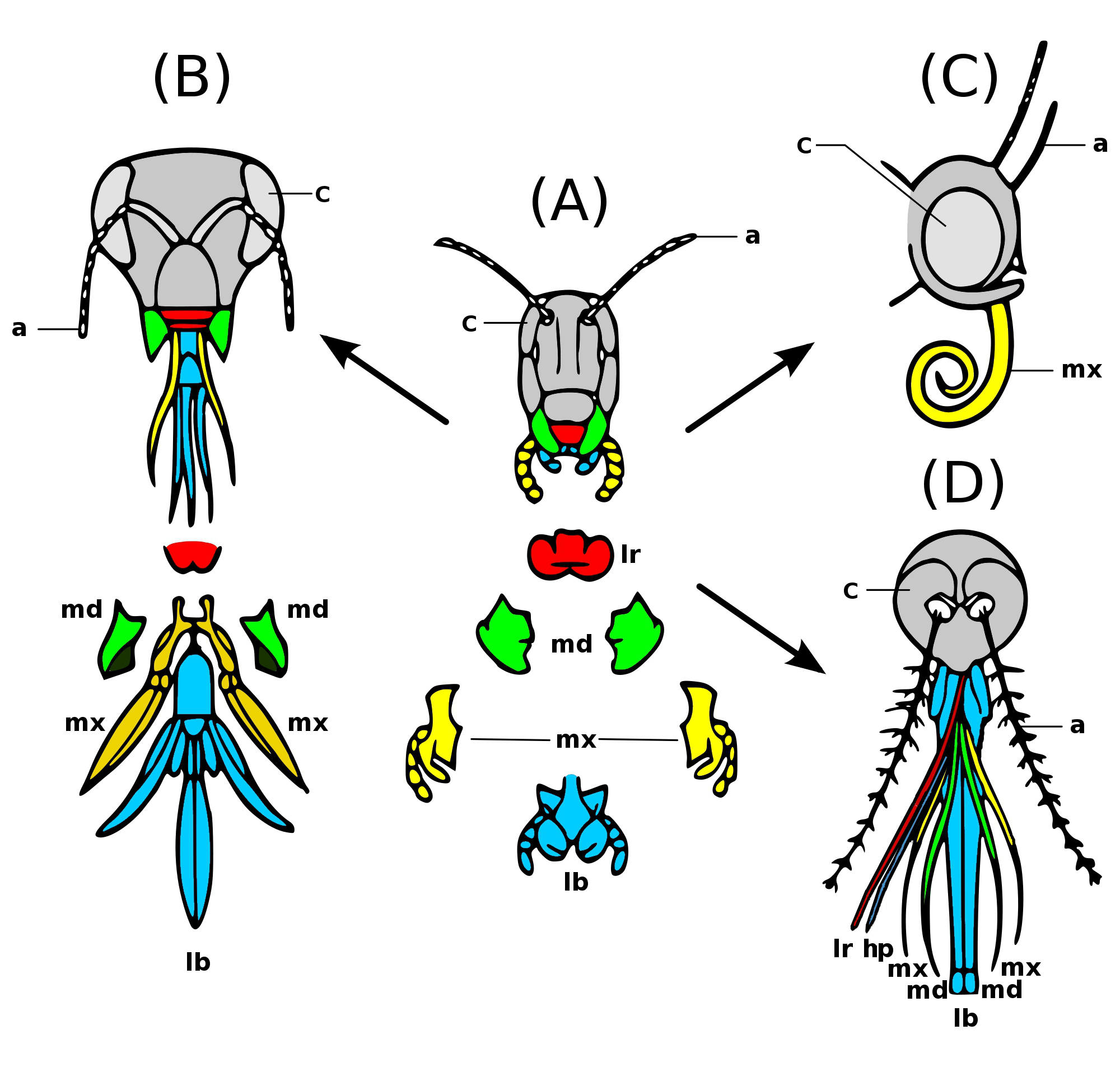|
Archaeognatha
The Archaeognatha are an order of apterygotes, known by various common names such as jumping bristletails. Among extant insect taxa they are some of the most evolutionarily primitive; they appeared in the Middle Devonian period at about the same time as the arachnids. Specimens that closely resemble extant species have been found as both body and trace fossils (the latter including body imprints and trackways) in strata from the remainder of the Paleozoic Era and more recent periods. For historical reasons an alternative name for the order is Microcoryphia. Until the late 20th century the suborders Zygentoma and Archaeognatha comprised the order Thysanura; both orders possess three-pronged tails comprising two lateral cerci and a medial epiproct or ''appendix dorsalis''. Of the three organs, the appendix dorsalis is considerably longer than the two cerci; in this the Archaeognatha differ from the Zygentoma, in which the three organs are subequal in length. In the late 20th ... [...More Info...] [...Related Items...] OR: [Wikipedia] [Google] [Baidu] |
Apterygote
The name Apterygota is sometimes applied to a former subclass of small, agile insects, distinguished from other insects by their lack of wings in the present and in their evolutionary history; notable examples are the silverfish, the firebrat, and the jumping bristletails. Their first known occurrence in the fossil record is during the Devonian period, 417–354 million years ago. The group Apterygota is not a clade; it is paraphyletic, and not recognized in modern classification schemes. As defined, the group contains two separate clades of wingless insects: Archaeognatha comprises jumping bristletails, while Zygentoma comprises silverfish and firebrats. The Zygentoma are in the clade Dicondylia with winged insects, a clade that includes all other insects, while Archaeognatha is sister to this lineage.A. Blanke, M. Koch, B. Wipfler, F. Wilde, B. Misof (2014) Head morphology of ''Tricholepidion gertschi'' indicates monophyletic Zygentoma. Frontiers in Zoology 11:16 doi:10.1186/1 ... [...More Info...] [...Related Items...] OR: [Wikipedia] [Google] [Baidu] |
Machilidae
The Machilidae are a family of insects belonging to the order Archaeognatha (the bristletails). There are around 450 described species worldwide. These insects are wingless, elongated and more or less cylindrical with a distinctive humped thorax and covered with tiny, close-fitting scales. The colour is usually grey or brown, sometimes intricately patterned. There are three "tails" at the rear of the abdomen: two cerci and a long central epiproct. They have large compound eyes, often meeting at a central point. They resemble the silverfish and the firebrat, which are from a different order, Zygentoma. Machilids undergo virtually no metamorphosis during their life cycles, and both nymphs and adults are generally inconspicuous herbivores and scavengers. Many species are restricted to rocky shorelines, but some are found in well-vegetated habitats inland. They can move very fast and often escape by jumping considerable distances when disturbed. Like all Archaeognatha, machilids ... [...More Info...] [...Related Items...] OR: [Wikipedia] [Google] [Baidu] |
Meinertellidae
The Meinertellidae are a small family of basal insects belonging to the order Archaeognatha. They are sometimes known as rock bristletails. These insects can be distinguished from members of the other Archaeognatha family, Machilidae, by the lack of scales at the base of the legs and antennae, head, and palps; along with possession of small abdominal sternites protruding slightly between the coxal plates. They can also be distinguished by patches of reddish to violet-brown hypodermal pigment on the appendages. Members of Archaeognatha are generally petrophilous ("rock-loving"), but species of Meinertellidae living in the Amazon have adapted to a life among the leaf litter on the forest floor, on the tree trunks and up in the canopy. In this wet environment, their eggs have a tolerance for being submerged in water. Meinertellidae comprise more than 170 species in 19 genera, grouped into the ''Machiloides'' group, ''Machilinus'' group, ''Hypomachiloides'' group, ''Machilontus'' ... [...More Info...] [...Related Items...] OR: [Wikipedia] [Google] [Baidu] |
Monura
''Dasyleptus'' is an extinct genus of wingless insects in the order Archaeognatha, and the only member of the family Dasyleptidae. They resembled their modern relatives and had a single lengthy filament projecting from the end of the abdomen. They also had a pair of leg-like cerci and some non-ambulatory abdominal appendages. The largest specimens reached or more, not counting the length of the filament. ''Dasyleptus'' was formerly placed in its own extinct order, Monura, but this is now treated as a suborder of Archaeognatha. Species The genus includes the following species: * ''Dasyleptus artinskianus'' – Early Permian ( Artinskian), Wellington Formation, Kansas, United States * ''Dasyleptus brongniarti'' – Middle Permian ( Roadian), Mitina Formation, Kuznetsk Basin, Russia * ''Dasyleptus lucasi'' (type species) – Late Carboniferous ( Gzhelian), Commentry Shales, France * ''Dasyleptus noli'' – Late Carboniferous (Gzhelian), Commentry Shales, France * ''Dasylep ... [...More Info...] [...Related Items...] OR: [Wikipedia] [Google] [Baidu] |
Insect
Insects (from Latin ') are Hexapoda, hexapod invertebrates of the class (biology), class Insecta. They are the largest group within the arthropod phylum. Insects have a chitinous exoskeleton, a three-part body (Insect morphology#Head, head, Thorax (insect anatomy), thorax and abdomen (insect anatomy), abdomen), three pairs of jointed Arthropod leg, legs, compound eyes, and a pair of antenna (biology), antennae. Insects are the most diverse group of animals, with more than a million described species; they represent more than half of all animal species. The insect nervous system consists of a insect brain, brain and a ventral nerve cord. Most insects reproduce Oviparous, by laying eggs. Insects Respiratory system of insects, breathe air through a system of Spiracle (arthropods), paired openings along their sides, connected to Trachea#Invertebrates, small tubes that take air directly to the tissues. The blood therefore does not carry oxygen; it is only partly contained in ves ... [...More Info...] [...Related Items...] OR: [Wikipedia] [Google] [Baidu] |
Thysanura
Thysanura is the now Deprecation, deprecated name of what was, for over a century, recognised as an Order (biology), order in the Class (biology), class Insecta. The two constituent groups within the former order, the Archaeognatha (jumping bristletails) and the Zygentoma (silverfish and firebrats), share several characteristics, such as of having three long caudal filaments, the lateral ones being the Cercus, cerci, while the one between (telson) is a Anatomical terms of location#Medial and lateral, medial cerciform appendage, specifically an epiproct. They are also both wingless, and have bodies covered with fine scales, rather like the scales of the practically unrelated Lepidoptera. In the late 20th century, it was recognized that the two suborders were not sister taxa, therefore Thysanura was paraphyletic, and the two suborders were each raised to the status of an independent monophyletic order, with Archaeognatha sister taxon to the Dicondylia, including the Zygentoma. Althou ... [...More Info...] [...Related Items...] OR: [Wikipedia] [Google] [Baidu] |
Dicondylia
Dicondylia is a taxonomic group (taxon) that includes all insects except the jumping bristletails (Archaeognatha). Dicondylia species have a mandible attached with two hinges to the head capsule (dicondyl), in contrast to a hypothetical ancestral mandible with a single ball joint (monocondyl); the members of Archaeognatha do in fact have dicondylic mandibles, though they are not identical to the structure seen in "true" dicondylic insects. Dicondyle mandible and other features The taxon is distinguished by the possession of a modified mandible with an additional joint canal, which also changes the muscle attachments of the mouth tools and allows a modified mandible movement compared to other mandibles (crustaceans, centipedes). This so-called dicondyle mandible has two joints with which it is attached to the head capsule, while non-insect taxa have only one single ball joint.Merkmale nach Klausnitzer 1997. The archaeognathans were once thought to have only a single articulation ... [...More Info...] [...Related Items...] OR: [Wikipedia] [Google] [Baidu] |
Zygentoma
Zygentoma are an order in the class Insecta, and consist of about 550 known species. The Zygentoma include the so-called silverfish or fishmoths, and the firebrats. A conspicuous feature of the order are the three long caudal filaments. The two lateral filaments are cerci, and the medial one is an epiproct or ''appendix dorsalis''. In this they resemble the Archaeognatha, although the cerci of Zygentoma, unlike in the latter order, are nearly as long as the epiproct. Until the late twentieth century the Zygentoma were regarded as a suborder of the Thysanura, until it was recognized that the order Thysanura was paraphyletic, thus raising the two suborders to the status of independent monophyletic orders, with Archaeognatha as sister group to the Dicondylia, including the Zygentoma. Etymology The name "Zygentoma" is derived from the Greek ('), in context meaning "yoke" or "bridge"; and ('), "insects" (literally meaning "cut into", in reference to the segmented anatomy o ... [...More Info...] [...Related Items...] OR: [Wikipedia] [Google] [Baidu] |
Epiproct
This glossary of entomology describes terms used in the formal study of insect species by entomologists. A–C A synthetic chlorinated hydrocarbon insecticide, toxic to vertebrates. Though its phytotoxicity is low, solvents in some formulations may damage certain crops. cf. the related Dieldrin, Endrin, Isodrin * D–F A synthetic chlorinated hydrocarbon insecticide, toxic to vertebrates. cf. the related Aldrin, Endrin, Isodrin A synthetic chlorinated hydrocarbon insecticide, toxic to vertebrates. Though its phytotoxicity is low, solvents in some formulations may damage certain crops. cf. the related Dieldrin, Aldrin, Isodrin G–L ... [...More Info...] [...Related Items...] OR: [Wikipedia] [Google] [Baidu] |
Insect Mouthparts
Insects have arthropod mouthparts, mouthparts that may vary greatly across insect species, as they are adapted to particular modes of feeding. The earliest insects had chewing mouthparts. Most specialisation of mouthparts are for piercing and sucking, and this mode of feeding has evolved a number of times independently. For example, mosquitoes (which are true flies) and aphids (which are Hemiptera, true bugs) both pierce and suck, though female mosquitoes feed on animal blood whereas aphids feed on plant fluids. Evolution Like most external features of arthropods, the mouthparts of Hexapoda are highly derived. Insect mouthparts show a multitude of different functional mechanisms across the wide diversity of insect species. It is common for significant Homology (biology), homology to be conserved, with matching structures forming from matching Primordium, primordia, and having the same evolutionary origin. However, even if structures are almost physically and functionally identica ... [...More Info...] [...Related Items...] OR: [Wikipedia] [Google] [Baidu] |
Ocelli
A simple eye or ocellus (sometimes called a pigment pit) is a form of eye or an optical arrangement which has a single lens without the sort of elaborate retina that occurs in most vertebrates. These eyes are called "simple" to distinguish them from " compound eyes", which have multiple lenses. They are not necessarily simple in the sense of being uncomplicated or basic. The structure of an animal's eye is determined by the environment in which it lives, and the behavioural tasks it must fulfill to survive. Arthropods differ widely in the habitats in which they live, as well as their visual requirements for finding food or conspecifics, and avoiding predators. Consequently, an enormous variety of eye types are found in arthropods to overcome visual problems or limitations. Use of the term ''simple eye'' is flexible, and must be interpreted in proper context; for example, the eyes of most large animals are '' camera eyes'' and are sometimes considered "simple" because a sing ... [...More Info...] [...Related Items...] OR: [Wikipedia] [Google] [Baidu] |





